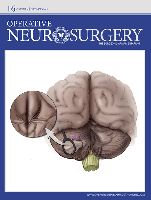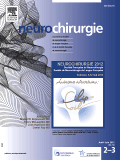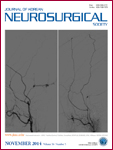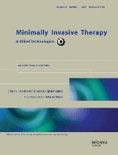
Operative Neurosurgery
Scope & Guideline
Fostering Knowledge to Shape the Future of Operative Techniques.
Introduction
Aims and Scopes
- Innovative Surgical Techniques:
The journal emphasizes the publication of innovative surgical techniques that improve patient outcomes and enhance surgical precision. This includes minimally invasive approaches, robotic-assisted surgeries, and novel methodologies for challenging neurosurgical procedures. - Interdisciplinary Collaboration:
Operative Neurosurgery promotes interdisciplinary collaboration among neurosurgeons, radiologists, and other specialists, encouraging studies that integrate various fields to improve surgical practices and patient care. - Video-Based Learning:
With a focus on visual education, the journal publishes 2D and 3D operative videos that serve as instructional materials for neurosurgeons, enhancing learning and practical application of surgical techniques. - Clinical Outcomes and Research:
The journal features studies that evaluate clinical outcomes of surgical interventions, aiming to establish evidence-based practices in neurosurgery and contribute to the improvement of patient care. - Technological Advancements:
Operative Neurosurgery highlights advancements in surgical technology, including intraoperative imaging, neuronavigation, and augmented reality applications, that optimize surgical procedures and reduce complications.
Trending and Emerging
- Minimally Invasive Techniques:
There is a significant increase in the publication of studies and videos focusing on minimally invasive surgical techniques, reflecting a broader trend in medicine towards less invasive approaches that reduce recovery time and complications. - Robotics in Neurosurgery:
The incorporation of robotic systems in neurosurgical procedures is on the rise, with more studies exploring their applications, benefits, and outcomes in various surgical contexts. - Augmented and Virtual Reality:
Emerging technologies, particularly augmented and virtual reality applications in surgical training and planning, are becoming increasingly prevalent, showcasing their potential to enhance surgical education and precision. - Neurosurgical Simulation:
The use of simulation for training and educational purposes is gaining popularity, with a focus on developing realistic training models and virtual platforms that improve surgical skills. - Neuroendovascular Techniques:
There is a growing emphasis on neuroendovascular techniques, particularly in the management of aneurysms and vascular malformations, reflecting advancements in endovascular interventions and their integration into surgical practice.
Declining or Waning
- Traditional Open Surgical Techniques:
There has been a noticeable decline in the publication of papers focused on traditional open surgical techniques, as the field shifts towards minimally invasive approaches and robotic-assisted surgeries. - Basic Neurosurgery Training:
The focus on basic neurosurgery training methodologies and foundational surgical skills has decreased, likely overshadowed by a growing emphasis on advanced techniques and technological integration in surgical education. - Conventional Imaging Techniques:
Research and discussions surrounding conventional imaging techniques are becoming less frequent, as newer modalities and enhanced imaging technologies gain traction in clinical practice and research. - Single-Center Studies:
The prevalence of single-center studies appears to be declining, with a shift towards multicenter collaborations that provide broader data and enhance the generalizability of findings. - Non-Surgical Interventions:
There is a noticeable reduction in articles addressing non-surgical interventions for neurosurgical conditions, as the focus has shifted towards surgical solutions and new technologies.
Similar Journals

Techniques in Coloproctology
Advancing innovative practices in coloproctology.Techniques in Coloproctology is an esteemed, peer-reviewed journal hosted by SPRINGER-VERLAG ITALIA SRL, dedicated to advancing the fields of gastroenterology and surgery with a specific focus on innovative techniques and clinical practices in coloproctology. Since its inception in 1998, the journal has been instrumental in fostering knowledge and research dissemination, exemplified by its current recognition in the 2023 quartiles as Q2 in Gastroenterology and Q1 in Surgery, reflecting its impact and relevance within the medical community. With a notable Scopus ranking of #73/551 in Medicine - Surgery and #53/167 in Medicine - Gastroenterology, it serves as a vital resource for practitioners, researchers, and students alike. Although it is not an open-access journal, the journal provides a unique platform for interdisciplinary collaboration and the sharing of cutting-edge findings, pivotal to the ongoing evolution of surgical techniques. As it continues to publish high-quality research through 2024 and beyond, the journal remains at the forefront of improving outcomes in coloproctological practices.

Journal of Neurological Surgery Part A-Central European Neurosurgery
Driving excellence in Central European neurosurgical research.The Journal of Neurological Surgery Part A – Central European Neurosurgery is a prominent peer-reviewed publication dedicated to advancing the field of neurosurgery and its related disciplines. Published by THIEME MEDICAL PUBL INC and based in Germany, this journal has been a platform for critical advancements in clinical neurology and surgery since its inception in 2012, and it is set to continue through 2024. With a current impact factor reflecting its influence in the medical community, the journal ranks in the Q3 quartile across the categories of Medicine (miscellaneous), Neurology (clinical), and Surgery for 2023, ensuring a robust participation from the academic and medical professionals alike. It is indexed in Scopus, highlighting its global recognition, with rankings of #248/551 and #257/400 in the fields of Medicine & Surgery and Neurology, respectively. The journal features a range of open access options, thereby facilitating unrestricted dissemination of high-quality research to a wide audience. As a valuable resource, it aims to promote the exchange of innovative ideas and research findings that can contribute to clinical practice and improve patient outcomes in neurosurgery.

Annali Italiani di Chirurgia
Elevating Surgical Research to New HeightsAnnali Italiani di Chirurgia is a prestigious surgical journal published by EDIZIONI LUIGI POZZI, dedicated to advancing the field of medicine and surgery through the dissemination of high-quality research and clinical insights. Since its inception in 1947, this journal has served as a vital platform for surgeons, researchers, and healthcare professionals in Italy and beyond, publishing comprehensive studies that cover a wide array of surgical disciplines. With an impact factor reflecting its notable standing in the scholarly community, the journal currently ranks in the Q3 category of surgery according to the 2023 category quartiles, and holds a Scopus rank of #371 out of 551, placing it in the 32nd percentile. While the journal does not offer open access, its rigorous peer-review process ensures that only the most relevant and innovative research reaches its readership. Based in Rome, Italy, Annali Italiani di Chirurgia continues to play an essential role in shaping the future of surgical practice and research, making it a critical resource for anyone involved in the surgical sciences.

Neurochirurgie
Advancing the Frontiers of NeurosurgeryNeurochirurgie, published by MASSON EDITEUR, stands as a prominent peer-reviewed journal in the fields of neurology and surgery, reflecting its commitment to advancing clinical practices and surgical innovations. With an impressive history dating back to 1955 and a convergence period extending to 2024, this journal serves a vital role in disseminating comprehensive research and updates relevant to both medical practitioners and researchers. Neurochirurgie holds a respectable Q3 ranking in clinical neurology and a Q2 ranking in surgery as of 2023, positioning it within the upper echelons of medical journals; its Scopus rankings further underline its growing influence, particularly in the surgical domain. Despite its non-open access model, the journal offers a platform where high-quality, rigorously vetted studies can be accessed, fostering an environment of knowledge exchange that is essential for the ongoing development of neurosurgical practices. For researchers, professionals, and students alike, Neurochirurgie presents an invaluable resource for staying at the forefront of neurological research and surgical advancements.

BRITISH JOURNAL OF NEUROSURGERY
Bridging science and surgery for improved patient outcomes.Welcome to the British Journal of Neurosurgery, a premier interdisciplinary publication dedicated to advancing the field of neurosurgery and enhancing clinical practice. Published by Taylor & Francis Ltd, this esteemed journal features a rich repository of peer-reviewed research covering innovative methodologies, case studies, and evidence-based practices across neurology and surgery. With an ISSN of 0268-8697 and an E-ISSN of 1360-046X, the journal is indexed in notable databases, reflecting a commendable standing in academia, categorized in Q2 for Surgery and Q3 for Medicine and Clinical Neurology as of 2023. Although currently not offering Open Access, the British Journal of Neurosurgery retains a readership of researchers, clinicians, and students eager for the latest insights impacting patient outcomes and surgical techniques. With an aim to bridge scientific inquiry and practical application, this journal plays an essential role in the global neurosurgical community, making significant contributions from its base in the United Kingdom.

Journal of Korean Neurosurgical Society
Empowering Minds in Neurosurgery and BeyondThe Journal of Korean Neurosurgical Society, with its ISSN 2005-3711 and E-ISSN 1598-7876, stands as a paramount resource in the field of neurosurgery, bridging clinical practice and cutting-edge research in both neurology and multidisciplinary neuroscience. Published by the Korean Neurosurgical Society, this open-access journal has been committed to disseminating invaluable knowledge to the global scientific community since its establishment in 1972. Located in Seoul, South Korea, the journal underscores its prominence with impressive quartile rankings—Q3 in Neurology (Clinical), Q3 in Neuroscience (Miscellaneous), and Q2 in Surgery for 2023. Its standing in Scopus rankings further emphasizes its impact, with a ranking of #195/551 in Medicine: Surgery and #235/400 in Medicine: Neurology (Clinical). By fostering a platform for innovative findings and advancements in surgical techniques, the Journal of Korean Neurosurgical Society aims to support professionals, researchers, and students alike in their pursuit of excellence and knowledge in neurosurgery and related fields, ensuring a brighter future for patient care and scientific inquiry.

Brain and Spine
Exploring the frontiers of neuroscience and neurology.Brain and Spine is a premier academic journal published by ELSEVIER, dedicated to advancing the fields of neuroscience and neurology. With its unique focus on the complex interactions between brain function and spinal health, this journal serves as an essential resource for researchers, clinicians, and students alike. Though currently lacking an official impact factor, its ranking within Scopus highlights its relevance, placing it in the 25th percentile for neuroscience (miscellaneous) and the 23rd percentile within neurology, indicating that while it is a developing journal, it holds potential for significant contributions to the field. Operating under open-access principles, it aims to disseminate valuable findings widely, ensuring that novel insights into neurological health are accessible to a global audience. Brain and Spine seeks to foster interdisciplinary collaboration and innovation, making it an invaluable platform for those striving to enhance our understanding of the brain and spinal cord's intricate functions and interdependencies.

MINIMALLY INVASIVE THERAPY & ALLIED TECHNOLOGIES
Exploring the Future of Minimally Invasive TechniquesMINIMALLY INVASIVE THERAPY & ALLIED TECHNOLOGIES, an esteemed journal published by Taylor & Francis Ltd, stands at the forefront of surgical innovation. With an ISSN of 1364-5706 and an E-ISSN of 1365-2931, this journal has been a pivotal resource since its inception in 1991, showcasing research innovations up to the year 2024. Recognized within the Q2 category in Surgery as reported in 2023, it ranks #143 out of 551 in the Scopus database, placing it firmly within the 74th percentile, thereby highlighting its significant contribution to the field. The journal aims to bridge clinical and technological advancements, providing a platform for researchers, practitioners, and students engaged in minimally invasive techniques and allied technologies. Although it operates under a subscription model, its rigorous peer-reviewed content ensures a wealth of high-quality articles, case studies, and reviews that advance knowledge and practices in surgery. The journal not only enhances understanding but also stimulates discussion around emerging innovations, making it essential reading for those dedicated to improving patient outcomes through minimally invasive strategies.

Indian Journal of Neurosurgery
Innovating the Future of Neurosurgery and Clinical NeurologyIndian Journal of Neurosurgery, published by GEORG THIEME VERLAG KG, serves as a pivotal resource in the field of neurosurgery and clinical neurology. With an ISSN of 2277-954X and E-ISSN 2277-9167, this Open Access journal has made significant strides since its transition to an accessible format in 2012, ensuring that groundbreaking research is available to the global scientific community. The journal, situated in Stuttgart, Germany, aims to publish high-quality and innovative research, reviews, and discussions that address contemporary challenges in neurosurgery. Despite its recent ranking of 465/551 in Medicine (Surgery) and 361/400 in Medicine (Neurology - clinical), with percentiles of 15% and 9% respectively, the Indian Journal of Neurosurgery fosters a platform for emerging ideas that can propel advancements in neurosurgical practices. Researchers, professionals, and students are encouraged to contribute to and benefit from this dynamic publication, which continues to influence the evolution of neurosurgical knowledge and practices.

Journal of Neurological Surgery Reports
Transforming research into practice for better patient outcomes.The Journal of Neurological Surgery Reports, published by GEORG THIEME VERLAG KG, serves as a pivotal platform for groundbreaking research in the field of neurological surgery. As an Open Access journal since 2012, it ensures that vital findings are accessible to a global audience, thereby promoting knowledge sharing and collaboration among researchers, clinicians, and students alike. With an ISSN of 2193-6358 and an E-ISSN of 2193-6366, this journal consistently ranks within the 41st percentile in the field of Medicine & Surgery and the 26th percentile in Medicine & Neurology (Clinical) according to Scopus, highlighting its commitment to quality and relevance. The journal's focus encompasses a wide spectrum of topics within neurological surgery, encouraging submissions that advance understanding and treatment of neurological conditions. By fostering a rich scientific discourse, the Journal of Neurological Surgery Reports plays an essential role in shaping the future of neurological healthcare.